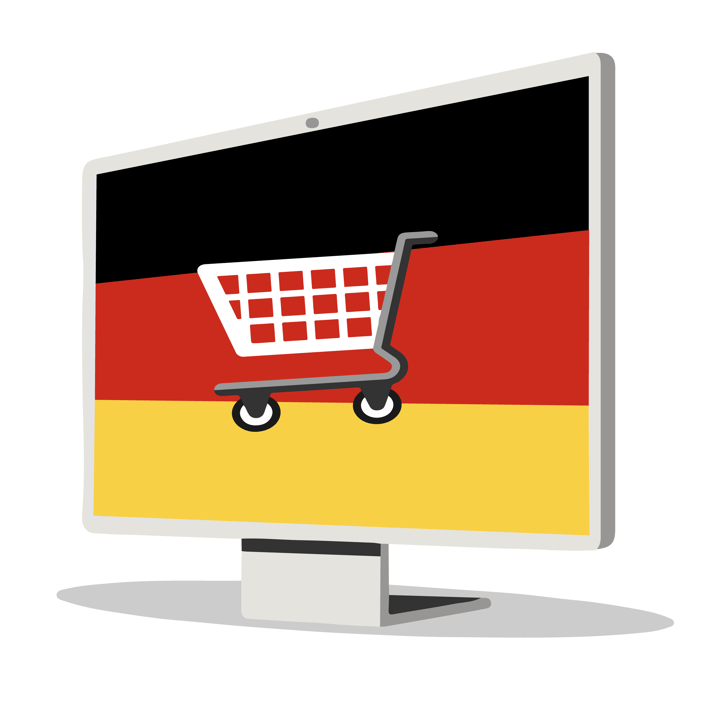The e-commerce market Germany

What is important in cross-border e-commerce with Germany?
Preparation is everything. If you want to be successful with your online business in foreign markets and compete against the big players like Amazon, Zalando or Ottos, you have to avoid shooting from the hip.
Nothing works without an internationalization strategy. This is important – for example, it was discovered that with a country-specific website and a similar offer, the average number of visitors per month can be increased from 12'500 to 370'000. This actually works!
The German market is the ideal entry market for your online business
The e-commerce Germany market is well suited as an entry market. The proximity to Switzerland and the same language are a good basis for this.
A few solid figures: 71% of German customers have already purchased abroad. Estimates suggest that in 2018 around 30% of their orders were from foreign countries.
In 2017, 502'000 customers ordered from a Swiss online shop. German customers are thus responsible for the largest international demand in Swiss web shops.
This represents enormous potential! This gets even bigger, as 13,5 million Germans can envisage ordering products in Switzerland. Remarkably, German customers consider Swiss online shops to be very trustworthy and secure. 28% of respondents say they would recommend Swiss online shops.
Here are a few more impressive amounts:
- Average e-commerce turnover per customer and year abroad: EUR 445.–
- Average e-commerce shopping basket value for orders abroad: EUR 51.–
- Average e-commerce shopping basket value for orders in the EU region: EUR 69.–
- E-commerce sales in Germany amounted to EUR 77 billion in 2020. (Source: Statista)
What do Germans buy in online shops?
If you want to be successful in cross-border e-commerce with Germany, you have to meet the requirements and wishes of German customers. We’ve compiled the most important points for you here:

Source: pwc: Grenzenlos shoppen: wie deutsche Konsumenten den Onlinehandel weltweit nutzen
They mainly buy fashion items, electronics, books, cosmetics and household goods. Many products in these categories are also ordered most frequently from online shops abroad. For example, 51% of the Germans surveyed have already bought fashion items abroad.
The reasons they give are price, availability and a larger product range. German customers are also convinced that the product quality in Swiss online shops is better.
Would you like to find out whether your product is suitable for the e-commerce Germany market? Click here to go to the Market Finder.
Design your online shop with German customers in mind
First, these are the devices Germans prefer:
As you can see: most German customers make their purchases on the Internet via a PC or laptop. However, around 25% of Germans shop via their smartphone. That’s why it’s important that you optimize your website for mobile shopping or possibly even create an app.
Most frequently used payment options in Germany
The payment options are enormously important for your customers. They allow you to have a strong influence on the shopping experience. This is because they have a significant influence on whether customers will use your online shop or not. Generally, the more payment options a web shop offers, the better. But this is not always so easy to implement in practice. Therefore, first limit yourself to the most frequently used and desired means of payment in the German mail order business. Here’s an overview:

Also interesting: 86% of merchants rate the non-payment risk of German customers as low or very low.
Online shop reviews are very important in e-commerce
71% of German customers research online before making a purchase. Of these, 93% say that their research has influenced them. Online customer reviews are the most important decision-making factor for German customers when shopping online. So if you give your customers the opportunity to leave reviews, you provide your potential customers with important information and thus increase their willingness to buy.
Shipping and logistics when shipping to Germany
As you have seen in the table, most products ordered abroad are light and small. This has a direct influence on the size of the delivery.
For example, 90% of orders in Germany are lighter than 2 kg and are therefore ideal for the low-cost letter channel and our small goods product.
Customs clearance when shipping from Switzerland to Germany
Only 8% of customers had to pay customs duties on their last purchase – as you can see:
Foreign customers are not used to paying customs duty on their international orders, and they do not expect to pay additional fees when they receive their order.
This calls for a good customs clearance solution! We are talking about a DDP solution (Duty Delivery Paid) – all import duties are paid by the shipper.
Customers also want to know specifically what the delivery costs are. 44% of German customers say they would pay more if customs clearance was covered by the sender.
You can find all the information on how to pay the correct customs duty when shipping abroad in our blog. There we explain how you can optimize customs clearance and thus increase customer satisfaction.
56% of German customers set their purchase limit below EUR 150.– for orders abroad. For shipments to the EU, you can use the IOSS shipping solution, which is a VAT registration to offer your customers in the EU a DDP solution so that the recipient no longer has to pay any additional VAT costs (import duties) upon receipt of the shipment. Great thing.
Optimize shipping speed for the German market
If you offer your customers multiple options when it comes to shipping, all the better. 89% of customers say that consignments from a neighbouring country should arrive within 7 days. 37% of customers even expect delivery to take only 2 to 3 days – less than the European average, by the way.
However: when customers have the choice between a fast, expensive delivery and a slow, cheap one, they usually opt for the slow variant without complaining about the longer delivery time.
And yet, 63% of German customers received their international delivery without having to pay delivery charges.
Delivery options in the e-commerce Germany market
Most German customers would like to have the delivery sent to their home. Many also agree to have it dropped off at their neighbour’s house. This option is rather unusual in other countries.

39% would like to confirm receipt by signature, while 20% would prefer that no signature is required.

Unfortunately, some German buyers have already had experiences with a poor tracking system. Therefore, 22% mention multiple and more reliable tracking options as an important requirement. Their preferred method of being informed about delivery options is e-mail.
![]()
43% would like to opt for sustainable delivery and 41% would also pay 10 cents more for it. Furthermore, 59% would like to have sustainable packaging and 48% would also pay 10 cents more for it. You can find everything about sustainability in e-commerce in our blog.
Want to know more? We explain how to export your products to Germany.
The other marketplaces for Swiss e-commerce retailers
In addition to Germany, it’s also worthwhile for Swiss online retailers to export to the other neighbouring countries. Our country reports on the neighbouring markets will help you with this. Here you will find all the information you need on the France e-commerce, Italian e-commerce and e-commerce in Austria.
A simple returns process is very important for customers from Germany
A good returns process is the second most important element for German customers when making an online purchase. This is something they take into account when making their purchase decision. From our own experience of making online purchases, we know that a good returns process is important as it saves a lot of hassle.
The number of items returned depends heavily on the product category. In Germany, for example, the return rate in the fashion sector is assumed to be around 50%. The return rate for electronics is also quite high at around 15%.
In Germany, 6% of orders from abroad are generally returned. This return rate is almost twice as high as in Switzerland. Find out how you can optimise the returns process in our blog.
When returning goods, German customers prefer to return them to Swiss Post (36%) and to have them picked up by the courier (23%).
Optimiere Dein Versand- und Logistiksetup mit wenigen Klicks
Dein Schlüssel zur Logistik-Optimierung
Bist Du bereit, Deinen internationalen Versand auf das nächste Level zu heben? Mit unserem Cross-Border-E-Commerce Optimizer erhältst Du in nur wenigen Minuten wertvolle Einblicke und konkrete Handlungsempfehlungen für Dein internationales Versand- und Logistiksetup. Beantworte einfach 13 Fragen und erhalte einen personalisierten Report, der Dir zeigt, wie Du Deine globale Logistik optimieren und Dein Geschäft ausbauen kannst.
Optimisez votre configuration d'expédition et de logistique en quelques clics
La clé de l'optimisation de la logistique
Optimise your shipping and logistics setup with just a few clicks
Your key to logistics optimisation
Ottimizzi la configurazione della spedizione e della logistica con pochi clic.
La sua chiave per ottimizzare la logistica
È pronto a portare le sue spedizioni internazionali ad un livello superiore? Con il nostro Optimizer per l'e-commerce transfrontaliero, può ottenere in pochi minuti preziose intuizioni e raccomandazioni concrete per la sua spedizione internazionale e la configurazione logistica. Basta rispondere a 13 domande e ricevere un rapporto personalizzato che le mostra come ottimizzare la sua logistica globale e far crescere la sua attività.






